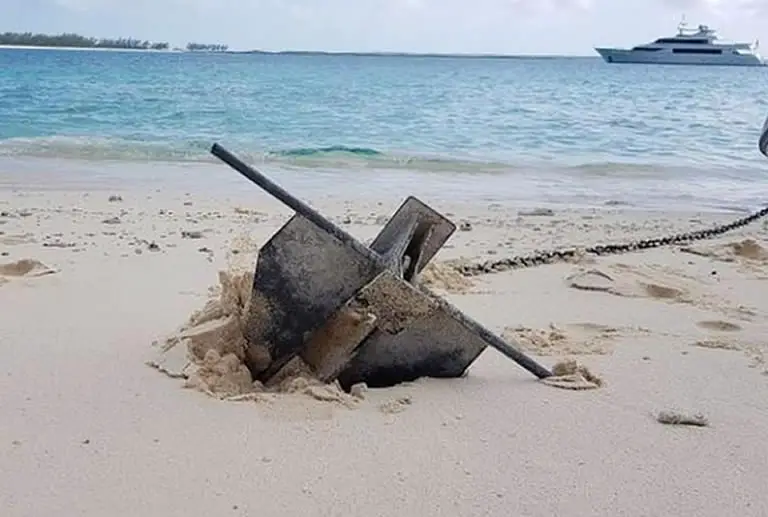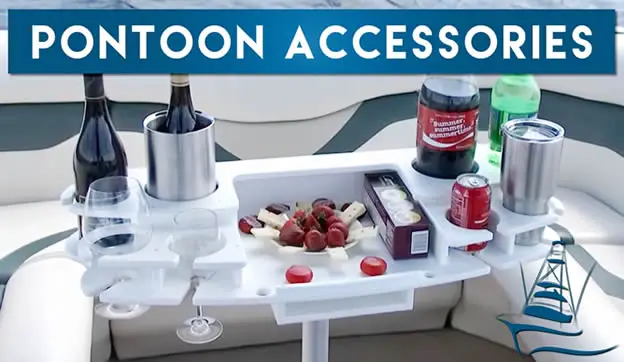Learning how to anchor a pontoon boat is an essential skill you need if you want to get the most from your pontoon experience. It is also a key safety skill you need as improper anchoring can lead to accidents. In this article I will show you how to anchor your boat quickly, securely and safely.
Contents
- How to anchor a pontoon boat effectively and safely in 6 simple steps
- 1. Choose a safe location for anchoring the boat
- 2. Select the correct rode length based on water depth
- 3. Get your boat into position (this is correct way to do it)
- 4. Anchors away – how to drop the anchor the right way
- 5. Set the anchor – feel for the resistance that let’s you know the anchor has hit the bottom
- 6. Ensure the anchor has dug in & has enough holding power
- Additional help for anchoring a pontoon boat
- Where to attach an anchor on a pontoon boat (key safety tip)
- 4 Helpful tools that can help you anchor your pontoon boat properly
- 3 Additional tips and tricks for better & easier pontoon boat anchoring
- The best way to retrieve and anchor – weighing the anchor
- Why safe anchoring is critical for a pontoon boat user
How to anchor a pontoon boat effectively and safely in 6 simple steps
There are only six simple steps involved in correctly anchoring a pontoon boat.
Follow these six steps and you will anchor your pontoon boat safely and effectively every time.
1. Choose a safe location for anchoring the boat
Choose an anchorage that is clear of other boats and obstructions. Ideally pontoons should face the wind or current.
You may need to determine whether you are dealing with a mud, sand or rocky bottom so you can drop the correct anchor if you have more than one onboard.
You must also determine if there are any obvious objects or obstacles underwater that can foul your line in the position you have chosen – if there are, anchor somewhere else.
How to choose an anchorage (video)
The below video is provided by a yacht owner who is anchoring just off the coast. Obviously, when you are in a pontoon boat the likelihood will be that you are on inland waters. However the advice he gives is just as applicable to pontoon boat owners.
2. Select the correct rode length based on water depth
Calculate the length of line you will need for your anchor.
You should not just drop the anchor in and let the line unwind!
An ideal rode length is a multiple of between 5 and 7 times the depth of water and to this add the distance between the waterline and your anchor point on the boat.
How to test water depth with your line (video)
3. Get your boat into position (this is correct way to do it)
Maneuver your vessel into position with the bow just ahead of where you want to drop the anchor.
Once positioned stop your boat completely.
4. Anchors away – how to drop the anchor the right way
Now it’s time to drop the anchor.
Slowly lower your anchor into the water from the bow.
It is worth ensuring that your anchor is still securely attached to the boat before you do this. You’d be surprised how many anchors are lost this way!
Do not throw or toss the anchor overboard, like you see in the movies, as this is likely to foul the line.
A nice gentle lowering of the anchor and rode will give you the best results every time.
5. Set the anchor – feel for the resistance that let’s you know the anchor has hit the bottom
Allow your boat to drift backward or put your vessel into a very gentle reverse.
This backward drift helps drive the anchor into the waterbed and gradually puts tension on your line.
Maintain moderate tension on your line to keep it straight.
6. Ensure the anchor has dug in & has enough holding power
Now the anchor is set you want to test its holding power.
You may need to power a reversing movement to aid with this if you have not been reversing to set the anchor.
Be gentle … you just want to make sure there is enough tension on the line to test that the anchor is holding.
You don’t want to pull it up with the power of your motor as you will likely damage your boat. Keep a note of your position intermittently to ensure you are secure and not drifting.
Additional help for anchoring a pontoon boat
Where to attach an anchor on a pontoon boat (key safety tip)
If you recall at the beginning of this article I advised you to anchor your pontoon boat from the bow.
The single most important piece of advice for pontoon anchoring is to never anchor by the stern.
The best location to install an anchor on a pontoon boat is near the bow.
Anchoring by the stern is incredibly risky and though it may seem convenient and logical to the novice boater, setting your anchor at the stern can cause the boat to capsize and sink.
Smaller pontoon boats are at particular risk as windy weather can wreak havoc with lightweight boats.
This is because the aft most part of the pontoon boat is usually carrying the most weight (engine, fuel tank, gear and passengers) and has the least freeboard.
This makes this part of the boat vulnerable to waves and swamping especially in bad weather and may lead to a pontoon boat sinking.
Remember always, the bow is by far the best place to attach an anchor on your pontoon boat.
You may also want to read our article on where to dock or anchor a pontoon boat and also may want to browse our 55 best pontoon boat accessories.
4 Helpful tools that can help you anchor your pontoon boat properly
- A pontoon boat anchor winch or windlass
is a handy boating accessory which doubles up as convenient storage unit for anchors of all types. With a pontoon boat anchor winch you can lower your anchor in a safe and controlled manner and do not have to worry about a muddy or weed tangled anchor soiling your boat’s seat upholstery.
- A quality pontoon anchor ledge
is a great way to lower and raise the anchor away from the main area of the boat for added safety and for inconvenience. A ledge also offers a great place for the storage of your anchor and winch without taking up valuable deck space.
- Anchor storage units may be padded or mesh and provide a place to secure your anchor and rope without it damaging your boat. A pontoon storage anchor block set
is a great option.
- Additional rope is always worth having on hand. Size your rope carefully measuring 1/8 of an inch of rope diameter for every 9 feet of boat length. Avoid excessive length as this will reduce the elasticity of your line. Be sure to read our guide on pontoon anchor rode here.
3 Additional tips and tricks for better & easier pontoon boat anchoring
- Be sure to choose an appropriate weight of anchor for the size of your vessel. A 14 -16 foot boat requires at least 20-30lb in anchor weight to be secure. Read our pontoon anchor guide for more information.
- For secure anchoring you may need more than one anchor. Experienced boaters recommend one anchor dropped off the bow, with a second one at the stern to stop your pontoon swinging excessively. With two anchors you can also ensure you have a generic anchor, for all bottom types, and a more specialized anchor for the type of bottom you regularly anchor in.
- Is your pontoon boat regularly in deep water? Then load a heavier anchor. Lightweight pontoons are prone to drift and the extra weight offered by a heavier anchor will assist you in maintaining your boat’s position. You can also add chain to your nylon rode to help with this as outlined in our anchor guide mentioned previously.
The best way to retrieve and anchor – weighing the anchor
Retrieving your anchor is relatively simple, especially if you have a winch. It does require caution though and a high quality PFD should always be worn.
Never set or retrieve an anchor unless you are wearing the appropriate safety equipment.
To weigh the anchor you simply lift it out of the water as vertically as possible when retrieving it from the bottom. Be sure to take care to always loosen and wash off debris from the rode as you raise it. And, do the same with the anchor once it is raised.
Why safe anchoring is critical for a pontoon boat user
The type of anchor you pick for your pontoon boat should never be an afterthought. So the first step is to get the correct anchor. If you don’t know which anchor you should get for your boat read our article what is the best anchor for a pontoon boat.
Although pontoon boats are shallow water recreational vessels, which are usually used in fair weather, it is not unusual to find your pontoon boat in rough water and in need of a strong holding anchor, especially if you are fishing.
You must ensure your boat is well equipped and that you can competently set and retrieve the correct anchor for your vessel. Getting things wrong can be fatal. In 2009, two NFL footballers and their friends were lost at sea after their fishing boat capsized in the Gulf of Mexico due to errors in anchoring.
So practice in calm water so you can handle rougher water and weather if you encounter it. Anchoring mistakes remain a significant contributor to capsizes and other marine fatalities so ensure you can competently use an anchor to keep yourself and your passengers safe.
Setting and retrieving your pontoon anchor is a key safety skill you need to know
Knowing how to properly anchor your pontoon boat is not only a key boating skill but a critical safety issue.
Setting your anchor appropriately means you can take full advantage of your pontoon boat, perhaps for boat camping, swimming or a leisurely afternoon with family and friends in a beautiful spot. But, it also means you have a key safety skill.
If you are caught adrift with engine failure or intercepted by bad weather, competent anchoring of your boat may help you master the situation and stay safe.



